Can I Use Rabbit Skin Glue
Rabbit Skin Glue is a traditional glue used every bit an ingredient in the preparation of genuine gesso and half-chalk footing; as a sealant (size) on canvas and wood panels before applying traditional gesso or an oil ground or to be painted on directly with oil paint; every bit the binder when making distemper pigment; and as a glue in some book making and other fine craft. Rabbit pare glue is made by rendering the gelatine from animals, ordinarily not rabbits, and the proper name designates a particular concentration of glue; hibernate mucilage is a name given to the same production at a different concentration. In that location are a few myths and some confusion most the utilise of RSG and there are some modernistic alternatives.
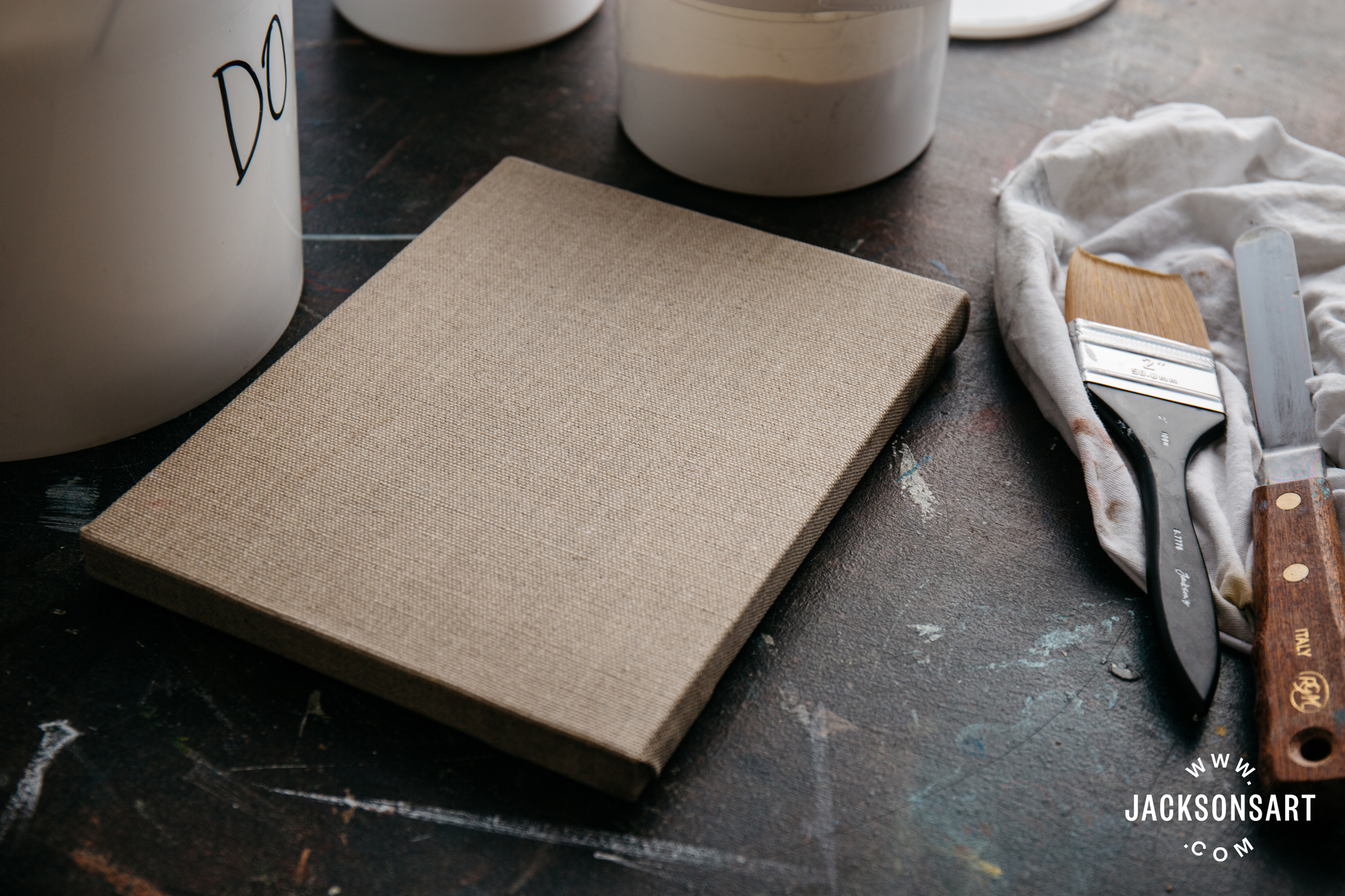
Why we Size
When preparing a canvas or wood panel that you plan to glaze with an oil ground or genuine gesso, the canvas or panel needs to be sized outset. This is a transparent layer that seals the surface and in the case of canvas (both cotton and linen) information technology tightens and stiffens the cloth. Canvas needs to be sealed from the effects of the drying oils in oil paint and oil grounds because over time the oil will dethrone the fabric fibres causing the canvas to darken and become breakable. This is the premature 'rotting' of the canvas you hear virtually. Wood panels exercise non need to be sealed from oil just sizing gives a better surface for oil grounds or genuine gesso grounds to sit on by evening out the absorbency of the wood which would otherwise have different absorbencies betwixt the grain lines and the wood betwixt them. Sealing the forest also prevents moisture from drawing up color, acids, glues, etc. from the woods into your gesso. This sizing can be done with an acrylic polymer (see the bottom of this commodity) or with rabbit skin glue which is often abbreviated as RSG.

RSG is bachelor as pellets, granules or ready-prepared.
Introduction to RSG
Rabbit peel glue (RSG) comes every bit a dry out production that you demand to make up with water. It tin come in fine or coarse granules or trivial cubes – in a plastic-lined paper pocketbook or plastic container. Because information technology is affected by water it needs to be stored somewhere dry out, so information technology tin can exist safely kept for many years. Information technology doesn't take as much of the dried glue as you might call back because you add together a lot of h2o to make it and it expands enormously. You besides utilise it very thinly. You lot make information technology up fresh every bit you need information technology and because it must exist heated gently you use a double-boiler (bain marie) process. Because I do not take a hotplate in my studio, but of course I take access to an electric kettle for tea, I use a very simple method using ii plastic buckets and a kettle of boiling water. You so apply it warm or make gesso with it warm. It is a jelly when cold and a thin liquid when warm. We also stock ready-prepared RSG which is a scrap more convenient, though it withal needs to exist melted and applied warm, and information technology is not as economical as hydrating the dried granules yourself.

The larger RSG pellets we sometimes stock.
The Corporeality of Water to Add to the Glue Granules
Glue strengths can vary depending on format and supplier. You lot can tell the concentration of the glue by how much it gels when it has cooled. For sizing rigid surfaces or making gesso, use i role granules to 12 parts h2o – when cooled information technology should be a firm jelly. For sizing sheet some experts use the same concentration, while some recommend a thinner consistency of 1 part granules to xx parts water – when cooled it should be a soft jelly which is easy to stir to an applesauce consistency, and still other experts recommend a thicker solution of one function granules to 8 parts water.
The consistency changes equally it cools so y'all tin can control the viscosity as y'all utilise it by using it at its warmest when it will be the near fluid or by letting it start to cool and thicken. If you use a higher concentration of glue you will need to apply fewer coats. If you apply the thinner concentration it will assistance you get the thin layers you desire but you will need to utilise more layers to make sure canvas is sealed enough to forbid oil strike-through.
Because there is some wiggle room in the ratio y'all do not need to be super authentic and can brand your glue using volumetric measurements – if y'all are using perhaps an old yogurt pot and so 1/4 pot of granules and 3 pots of water = 12:one. Simply measuring by weight volition ever be more authentic because the size of the granules can change the amount of mucilage in a volume. A kitchen or postal scale works well. 12:1 requires 35g of dry glue granules per litre of water. 20:1 requires 20g of granules per litre of water. And if you lot switch to a different brand or format of dry out glue then you lot may get different results then you had been used to, because the new dry glue might exist weaker or stronger. For panels I personally use 12:1 and I measure past volume.
The Yield or How Much to Make
Yous may not need to make as much as you first call up, as you apply the RSG thinly and you can't store the leftovers for very long, even in the fridge. Making upward a litre should allow you to size eight small panels (20x25cm) and use the residue to brand gesso for them the next twenty-four hours. You will utilise nearly i/3 to size and then the next day rewarm the 2/3 left to brand upward the gesso that you will need. To make the litre of RSG at a concentration of 12:1 requires 1 litre of h2o and 35g of dry glue granules.
The Preparation Method
To make up some RSG you volition need two like sized containers that tin withstand boiling water and one needs to fit inside the other – I use empty Golden Gel iv-litre buckets. Beneath we show a ii.5 litre bucket in a 5 litre bucket. If yous have a hot plate you tin can put a pudding basin in a saucepan.
Put 8-twenty parts cold tap water and 1 role RSG pellets in a container and embrace and leave until the mucilage particles have bloated and increased greatly in size, no need to refrigerate. For large particles of glue like the cube format this volition be overnight or longer, for the fine granules information technology could take merely a few hours.
The next day, boil the kettle, pour a few inches of hot water in the other container and set the bucket with the cold water and soaked glue pellets into the hot h2o bucket. You don't want to get the mucilage too hot or it will be damaged, but the cold water inside and the boiled water outside should exist just right. Because my studio is cold the bucket of soaked rsg and h2o is quite cold so the boiled kettle water cools apace enough to not be also hot. If you are working in warmer temperatures possibly hot tap h2o might be enough. The same is truthful for gelled RSG stored in the fridge, information technology comes out quite cold and so the boiling water in the bain marie should absurd fast enough to not damage the glue. You want to warm it non cook it. If you are using a thermometer, keep the temperature below 70C. Stir and it will slowly cook into a liquid glue with the consistency of milk. I take heard that you tin filter the glue through an old pair of tights to eliminate contaminants only I have never needed to do this.
When it cools it volition be a jelly. Y'all can store it for some fourth dimension in the refrigerator and re-melt it, but it is best used as soon every bit information technology is set, and then try to brand up only what you need. I have not stored it for longer than two weeks and I accept read that nigh people recommend 1 week.
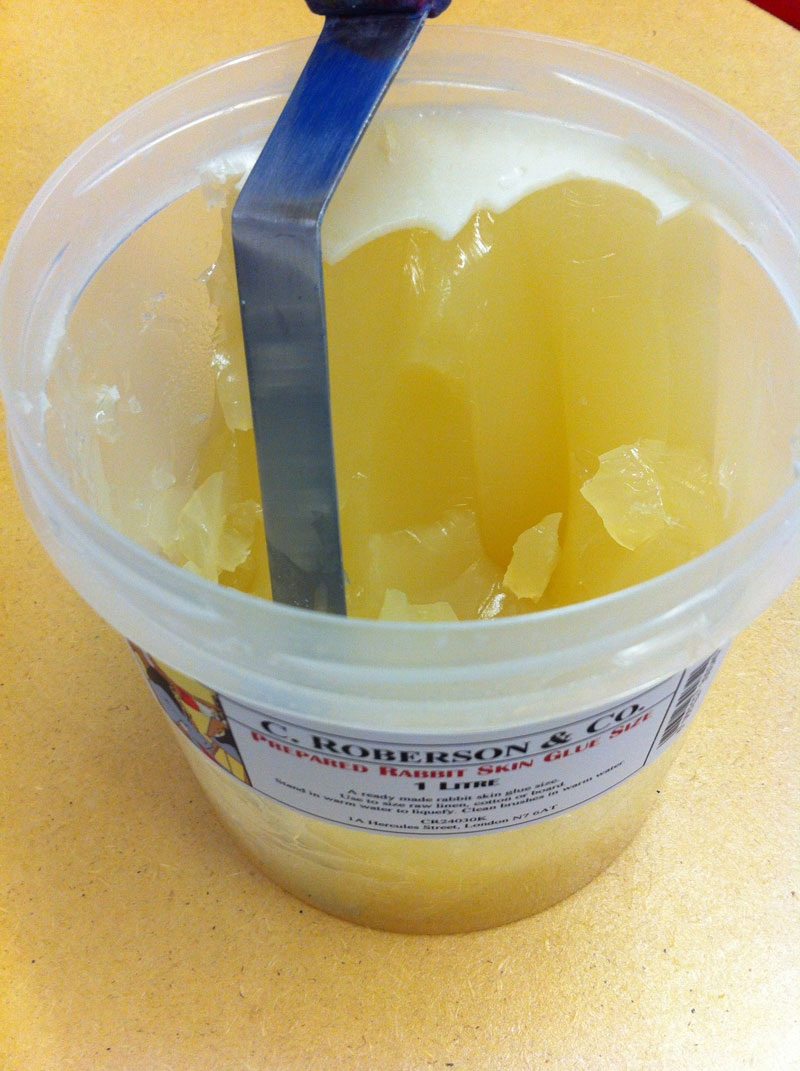
Nosotros too sell ready-prepared rabbit skin glue that is already a jelly and has been strained/filtered and only needs to be melted gently in a bain marie gear up-up (simply like before- do non go information technology too hot). For some reason this kind doesn't need refrigeration, it must take a preservative. It is user-friendly but since you don't add 12 parts water to it like you do with the dried RSG, it is not every bit economical.
Preparation step by footstep in photos
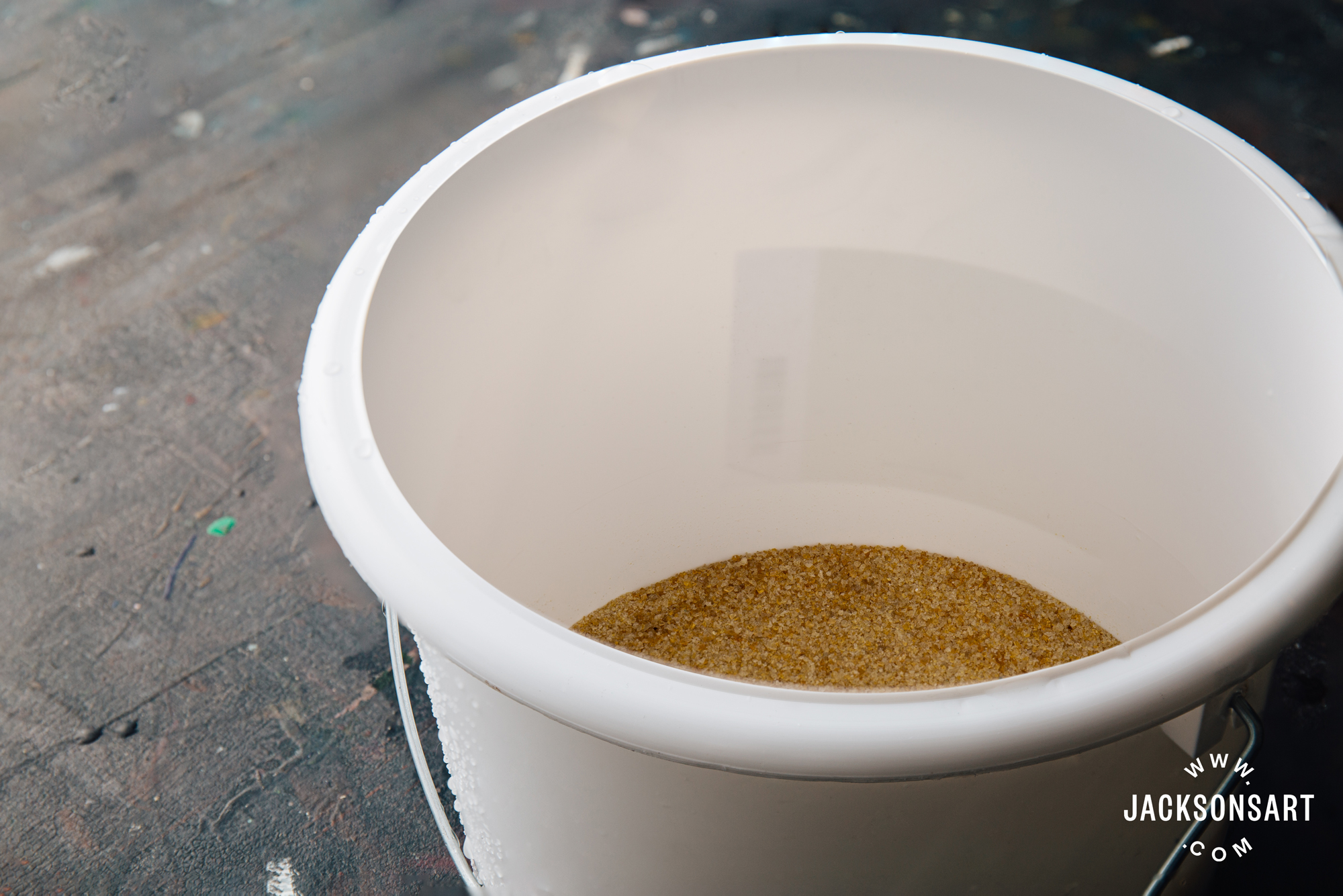
This small amount of dry RSG volition make a full bucket of glue after it has captivated water. We are creating a 12:1 solution.
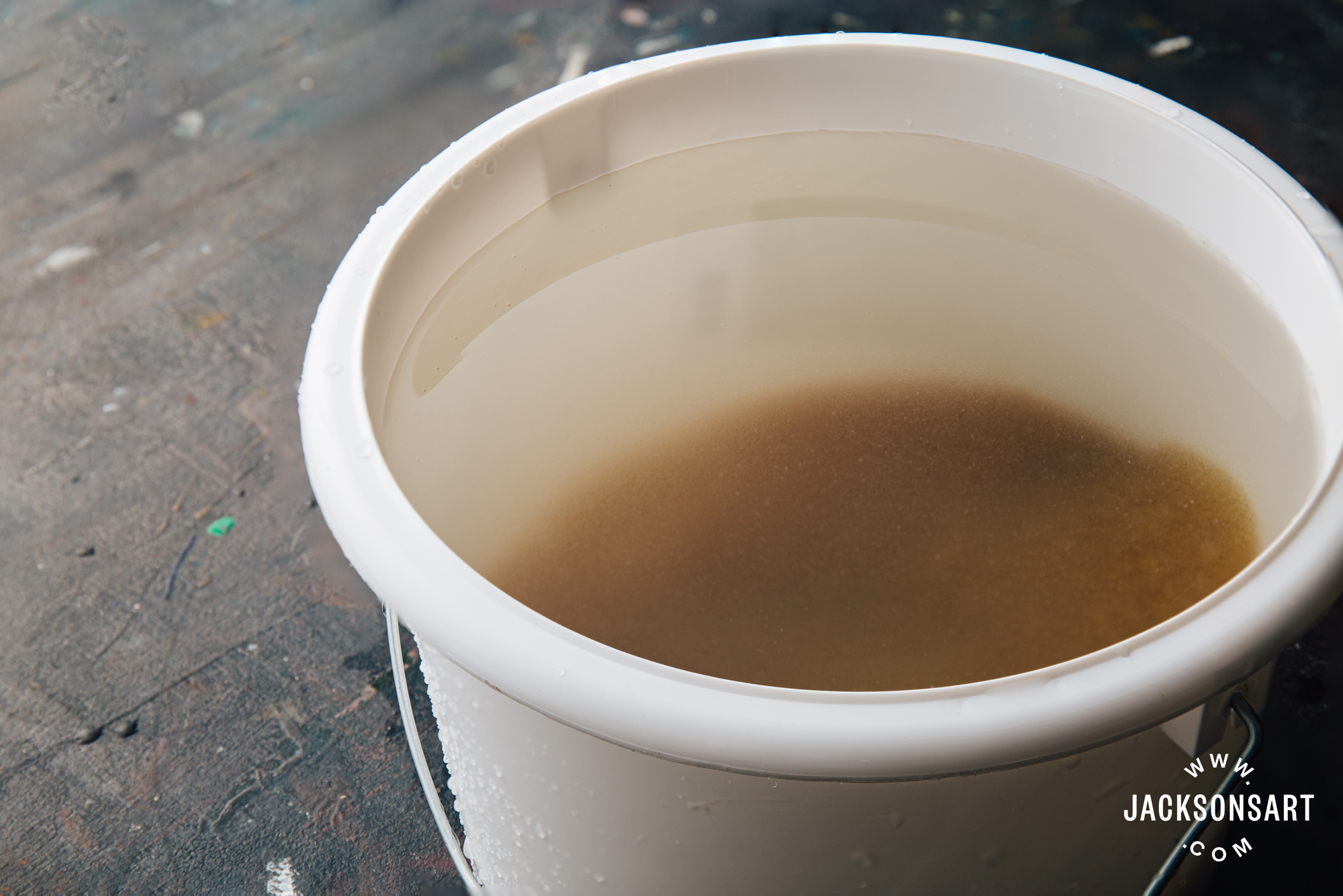
The saucepan is now filled with cold h2o and the mucilage granules have already started to neat.

The glue granules take now captivated all the cold water they tin. Since these are modest granules this took just a couple of hours.
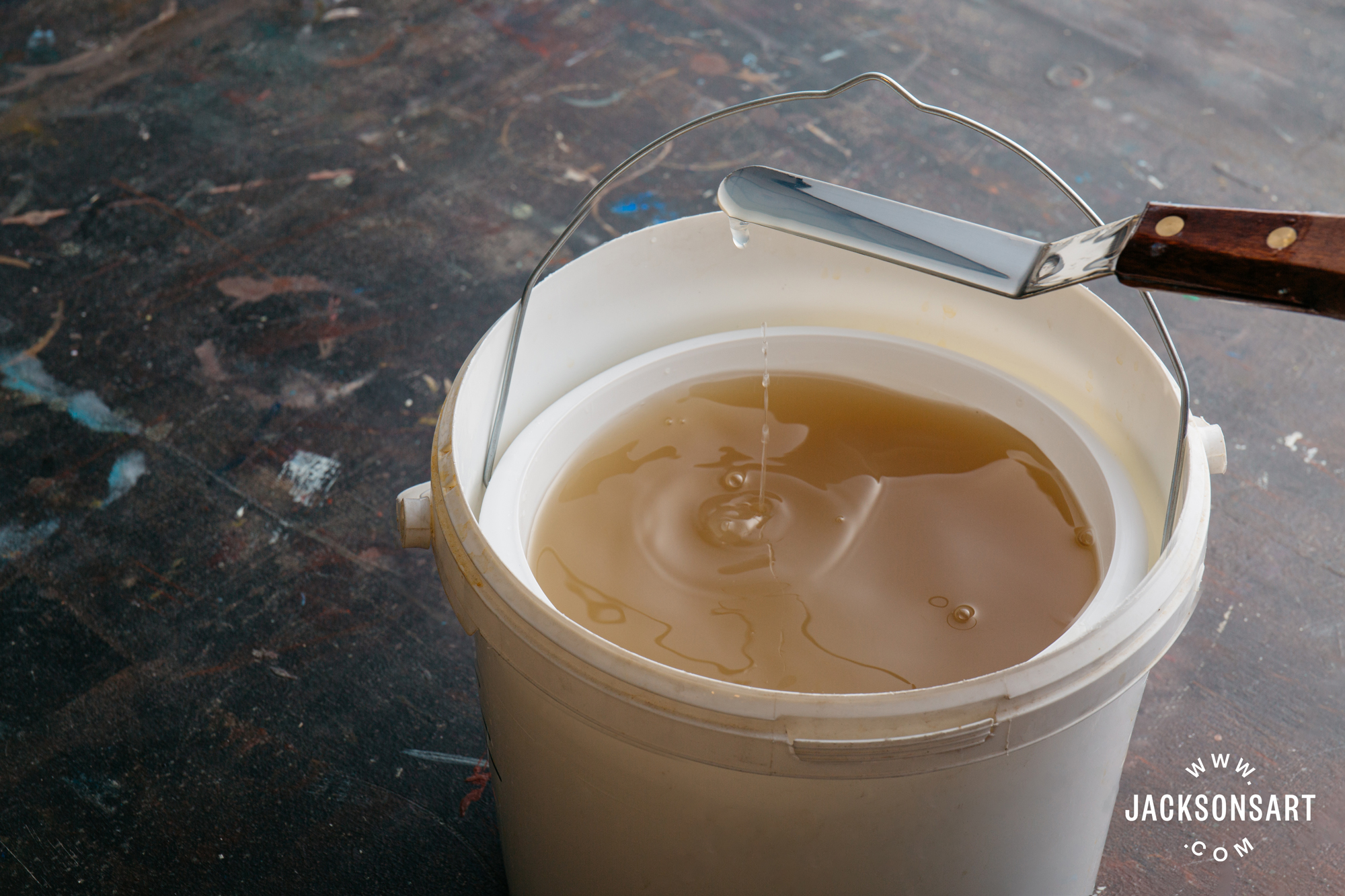
The bucket of cold water and glue was placed into a bucket with a few inches of just boiled water and stirred and in a few minutes the mucilage was prepare. Discover how thin the fluid is every bit it drips from the palette pocketknife.
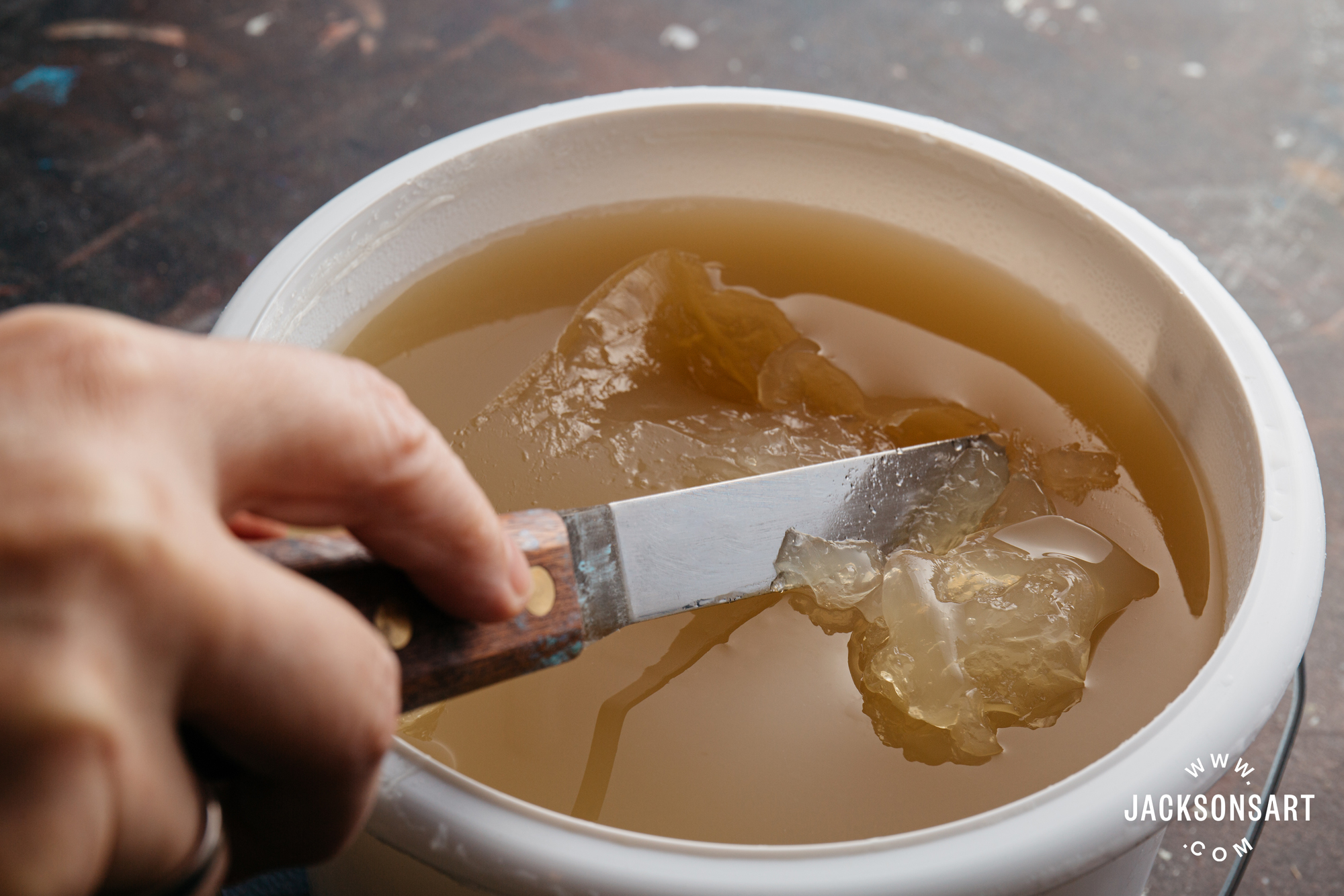
As it cools, the solution begins to gel. It can be re-melted by gently warming again.
Fresh Rabbit Peel Gum does not smell bad
Years agone, when I first used it, I was prepared for a bad odour because I had heard that people avoid RSG considering it smells foul. But mine had well-nigh no smell. I take since smelled spoiled RSG left in a closet in a classroom that smelled terrible, like a decomposing mouse. I retrieve the evil-smelling stuff is remembered from art school where stuff gets left over and reused and not refrigerated in which case it will spoil. It should only smell bad when information technology has spoiled. Do not apply old, stinky or mouldy gum.
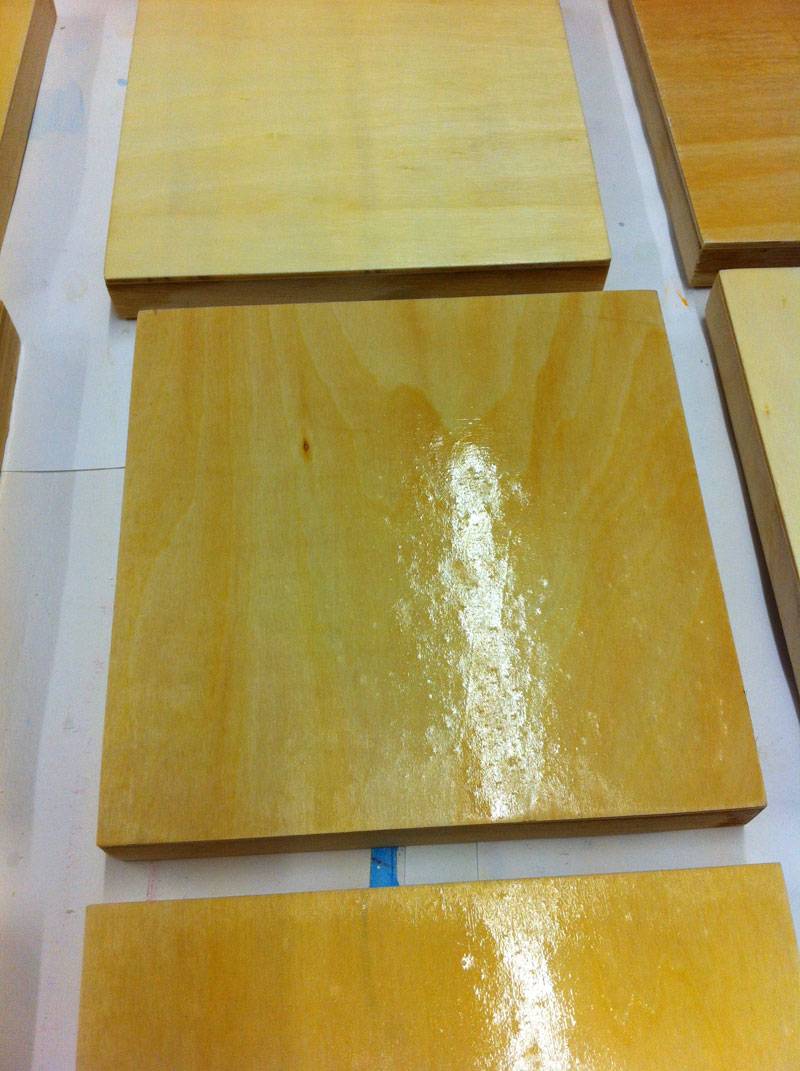
Applying RSG to Panels or Sheet
Apply the gum size thinly, evenly, chop-chop and in 1 direction while warm. Permit it become touch dry out between layers (less than an hour). And so utilise the following layer in a crosswise direction. All layers must exist thin because a thick layer of rabbit pare gum is more likely to scissure after, even on panel.
To size a console utilize ii layers while very warm and flowing. I utilise information technology straight from the bain marie set-upwards – brushing it onto forest panels held at an angle with the draining corner over the bucket for the excess to run back in. Some people mix in a modest amount of the whiting that you will use to make your gesso, which allows yous to see a milky coating evenly on your surface, and so no surface area is missed.
To size cotton canvas use two-3 layers, while a bit cooler simply still warm, rewarm if necessary to keep the glue fluid. For linen with its more open weave yous may wish to use it with a brush or large palette pocketknife when it is fifty-fifty a bit cooler, starting to thicken, to better make full the gaps in the weave. There is no need to add together whiting for applying the size to canvas, if you wish it to remain clear, y'all just need to be careful to coat the whole canvas.
While you lot are working with it, as it cools it gels and you just demand to change the cooled hot water for fresh hot water to re-cook the glue. Since the glue is no longer as cold as when it started, exist careful with getting the bath water as well hot; you can re-cook is as ofttimes equally yous like and then long as it doesn't go also hot.
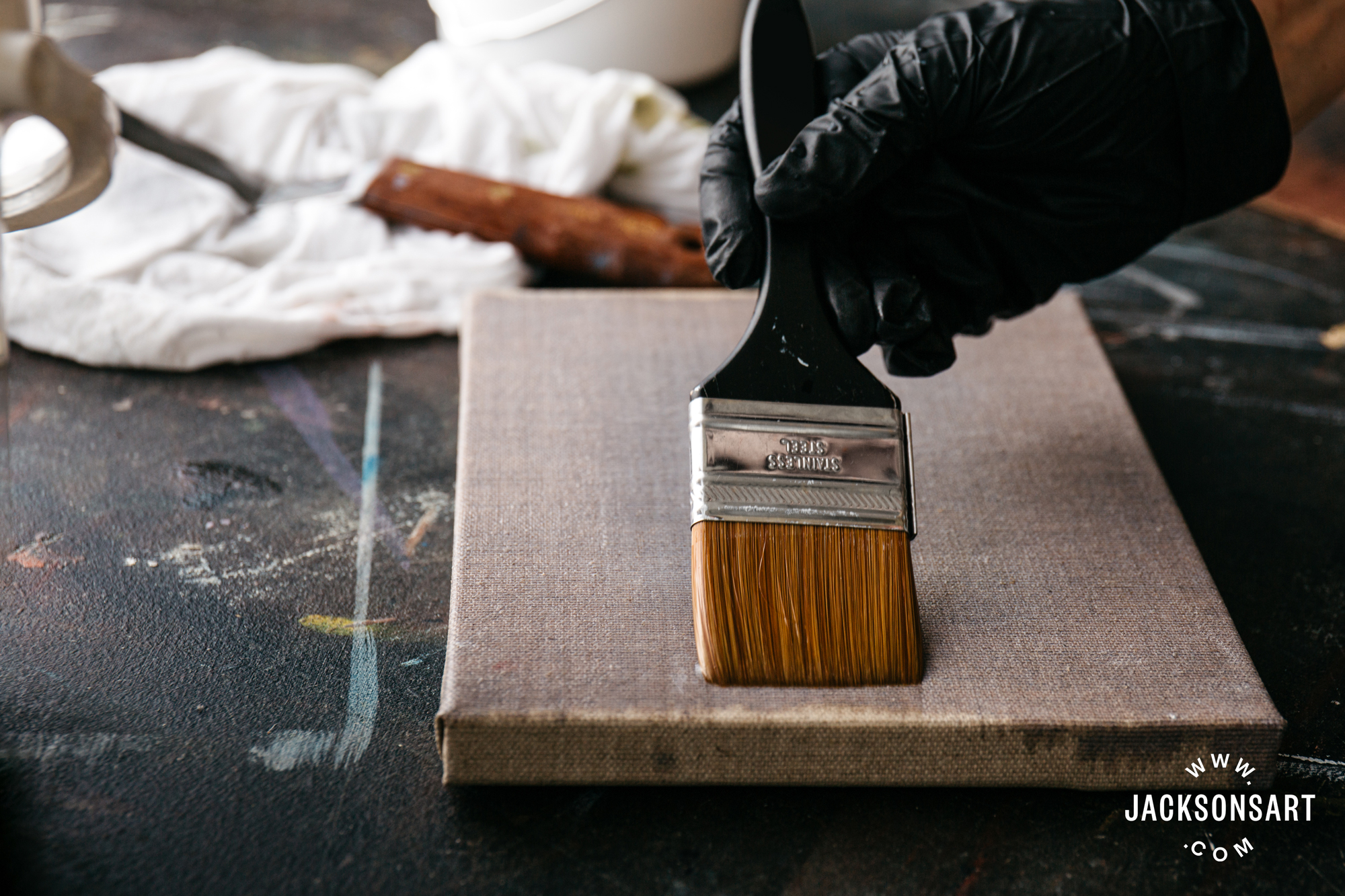
Brushing on the first coat of RSG to exist either a articulate primer or a sizing underneath an oil primer.
On sail the RSG should cause the fabric to shrink and this may be so pronounced as to warp your stretcher bars, especially with linen. For this reason some artists staple the sail evenly to a wall in their studio to size information technology and so stretch it on stretcher bars and utilize the ground. Or utilise tacks to stretch it temporarily for sizing then re-stretch it for applying the ground. Information technology is much easier to stretch linen evenly on your bars if it has already been sized, because information technology is stiff enough to non be wavy and stretchy. Which is why we stock Glue-Sized Linen, and then yous just need to stretch information technology and utilise a last coat of RSG or a basis. Think of it every bit semi-stiffened or partially-prepared linen.
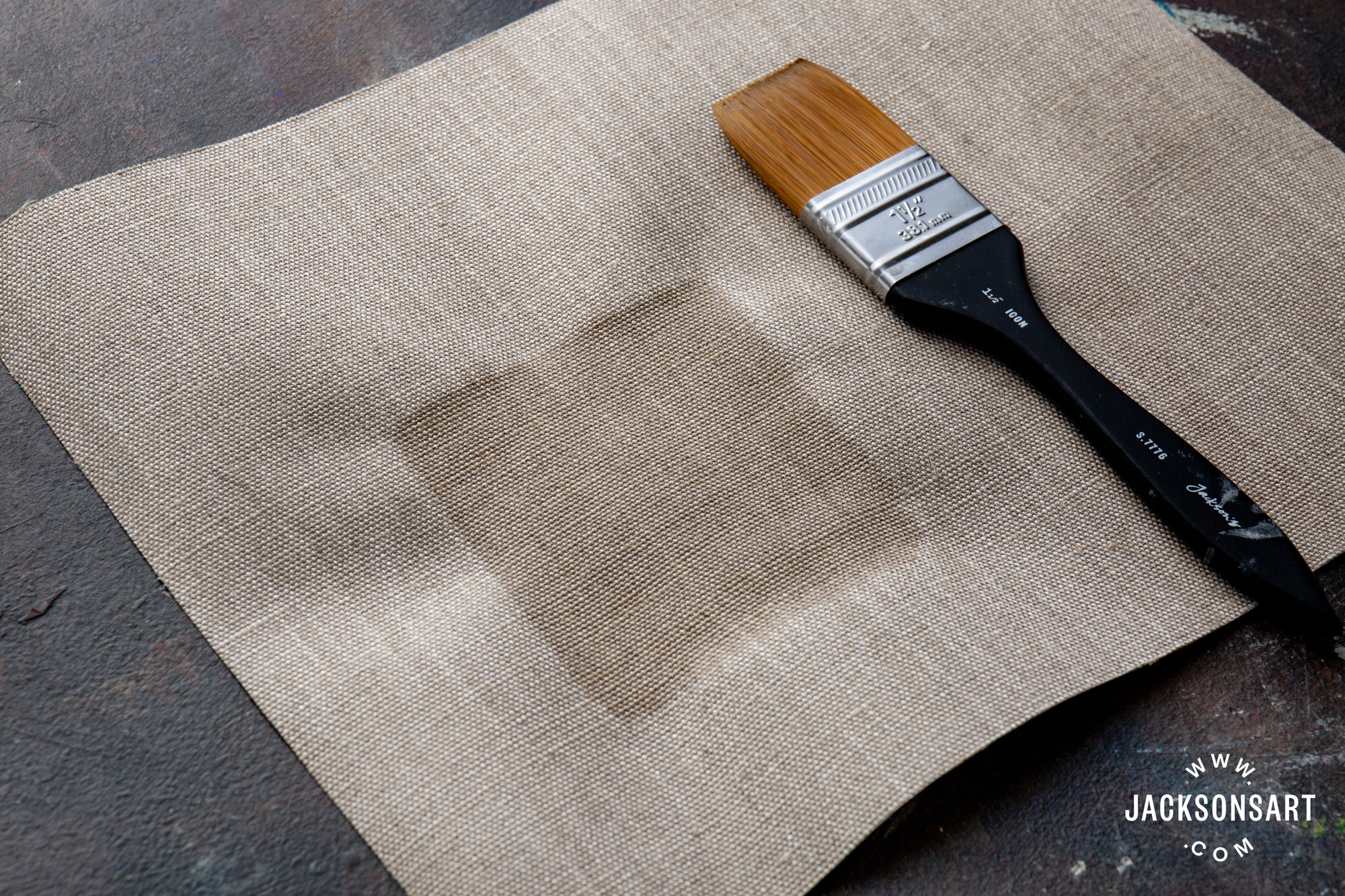
Observe how after drying, the RSG darkens, stiffens and shrinks the linen canvass.
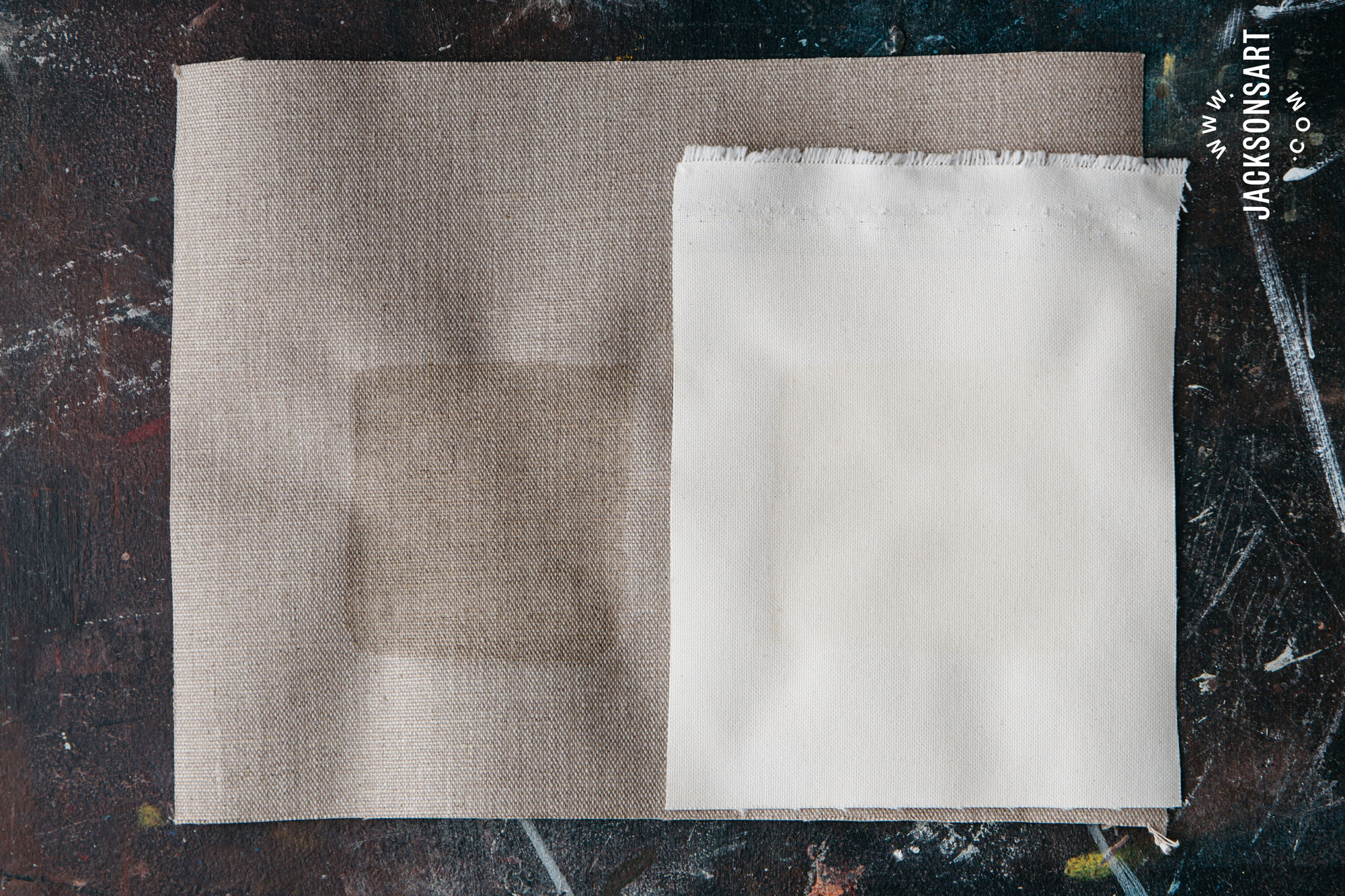
Notice how the RSG darkens, stiffens and shrinks the linen canvas only is nearly invisible on the cotton canvas.
The at present sized canvas or panel needs to dry out flat for at least 12 hours – and allow information technology dry naturally, don't use a drier to speed up the drying. If your console bends because it is thin or not cradled yous may want to paint RSG on the back to flatten it out.
Painting on RSG-sized Canvas
If you do not wish to utilize a ground, you tin paint with oils directly onto the RSG-sized surface. Many artists like the expect of a clear sized linen surface and the surface feel of painting directly onto the RSG sized canvass, so they practise non utilize a ground. To test if you have enough RSG on the sheet to seal it properly, bank check the dorsum of the canvas for any seepage or strike-through of the oil pigment. If you lot paint with very fluid oils that are thinned with a lot of solvent you lot may find that the RSG volition non be able to withstand the penetration. Do not pigment with acrylics or put acrylic primers on RSG as they will not stick well.
Applying a 18-carat Gesso Basis to the Sized Panel
Genuine gesso is a mixture of glue and chalk and like the size it is applied warm. It is used for, amid other things, making panels for egg tempera painting because acrylic primers are not absorbent enough and the paint lifts off as you begin layering it. Information technology is also an absorptive enough surface for encaustic painting. The ultra-smooth, soft, very white and absorptive surface is also preferred by some oil painters, especially if they make meticulous renderings. Genuine gesso is only used on panels because information technology is non flexible, and so it volition crack if used on stretched canvas.
At that place is an efficiency to making many at once. It doesn't take much more fourth dimension to size and gesso 8 panels than one. For instance, every bit you are applying size to the eighth panel the first is probably dry plenty to get the second layer of size. Then when applying the five or more coats of gesso, you just wait for a glaze to become matt before applying the next, every bit all coats must be applied in ane session otherwise the coats will not bond together. So again, by the time that you accept coated the eighth the first is probably prepare for the next coat and in this mode you can do a serial of eight in the same time every bit i.
Making Genuine Gesso
Truthful gesso or traditional gesso (as opposed to acrylic primer which is oft called gesso) is made from warm 12:1 RSG and an inert white paint. This pigment tin can exist chosen a number of things: gypsum, chalk, marble grit, or whiting. (The give-and-take gesso comes from the discussion gypsum which is why it is pronounced like "jesso".) You can substitute upwards to twenty% of the inert white paint with titanium white pigment if y'all want a brilliant white surface.
Measure the amount of RSG you have and put it dorsum in your double boiler. Measure 1.5 times the volume of inert white pigment, at Jackson'south we call it whiting. Slowly slip the powder into the liquid without stirring or creating air bubbling, let it form a mound and let it settle and soak for 10 minutes. Then gently stir it with a wet castor, trying to create no bubbles.
Utilize the gesso to the sized panel in ane direction back and forth, rotating the panel to practice each subsequent coat in the crosswise direction to the last. When the shine has left apply the next layer, all 5-10 layers need to be applied the same day for the layers to bond. If there are whatsoever cracks, you lot are not waiting long enough, but the next layer should fill the cracks. If yous are getting pinholes that is from air bubbles and you lot should tap you bucket of gesso sharply on the table to cause the bubbles to rise to the surface and so let the gesso settle for thirty minutes before continuing. You can burnish bubbles out by rubbing with a moisture muslin textile, wet smooth block of woods or your wet finger. The layers are transparent while wet and until y'all have built up some coats.
Let your console dry for iii days and then smooth it. Fine sandpaper or a sanding sponge are best used wet because the dust is dangerous to breathe. Equally well as the face, sand the sides to bevel them a bit. If you demand a very absorbent surface use the panel as it is. If yous wish to reduce the absorbency for oil paints possibly, then you can add a final coat of RSG.
A like substance for making painting panels is chalk ground, which has a lower percentage of whiting, 1:1. Half chalk ground is chalk ground with linseed stand oil added. Both of these are generally mixed on a glass palette with a painting pocketknife, working the powder into the liquid in a like fashion to making paint. These can be practical to stretched sheet because the oil content or the higher mucilage content allows them to be flexible enough.
Applying an Oil Basis to the RSG-Sized Canvas or Console
An oil footing is composed of a drying oil (ordinarily linseed oil), an alkyd resin or both, with an inert white pigment for tooth and usually titanium white pigment for opacity. It is similar to a layer of oil pigment, so needs to dry out or cure before painting on. Read the instructions on the container and prepare your canvas or panel ahead of time and permit it to cure for the recommended time. The surface will yellow because of the linseed oil but if you cover the whole surface with paint this will not testify. The surface in not very absorbent and then the paint slips around and the wet paint tin be wiped away hands. Many oil painters find it a superb surface much preferable to an acrylic footing.
The Drawback of RSG
There is a conservation drawback to using RSG. It is hygroscopic, meaning it absorbs water from the air over fourth dimension, causing the mucilage to swell or shrink as humidity levels change and the repeated flexing of the surface underneath the oil pigment causes the oil pigment layer to cleft. RSG is considered to be a major cause of cracking in oil paintings by most modern conservators. Although it is traditional and has been around for many years, museums have had to piece of work difficult conserving some paintings.
The almost damage occurs when there are rapid and broad fluctuations in relative humidity, more so than very slow or modest changes. If the relative humidity gets to a higher place 85% then the RSG has no rigidity at all then contributes no support and the canvas is gratis to shrink and then the paint can do fiddling simply crack or delaminate. Merely in most climates that is rare. Information technology is most problematic with very old paintings where the oil paint has become very breakable over time.
Because of this changeable, reactive quality of the RSG some people choose instead to use acrylic size on canvas and panels to seal underneath their oil ground for oil painting. Simply it is even so necessary to apply RSG as an ingredient in genuine gesso for egg tempera painting. Additionally there are reports that canvas prepared with RSG becomes brittle, but so does oil pigment if painted on any stretched canvas, so if yous are worried well-nigh the dandy of oil pigment, conservators recommend but painting on a non-flexible surface such as a wood console or sheet fastened to a wood panel, and never on a stretched canvas.
To amend the problem with RSG apply information technology as thinly every bit you can become away with while nonetheless accomplishing your purpose; the less yous take on your surface the less it can keen and shrink. And of course, storing your work in a less child-bearing environment volition help. At that place are modern synthetic alternatives, though the surface does not have the same wait or experience equally RSG, which is often described as sparkling on the surface of the sail and allowing oil pigment to sink into the surface. And they don't tighten the fabric like the RSG does. In fact, modern sizing alternatives often cause the canvas to slacken.
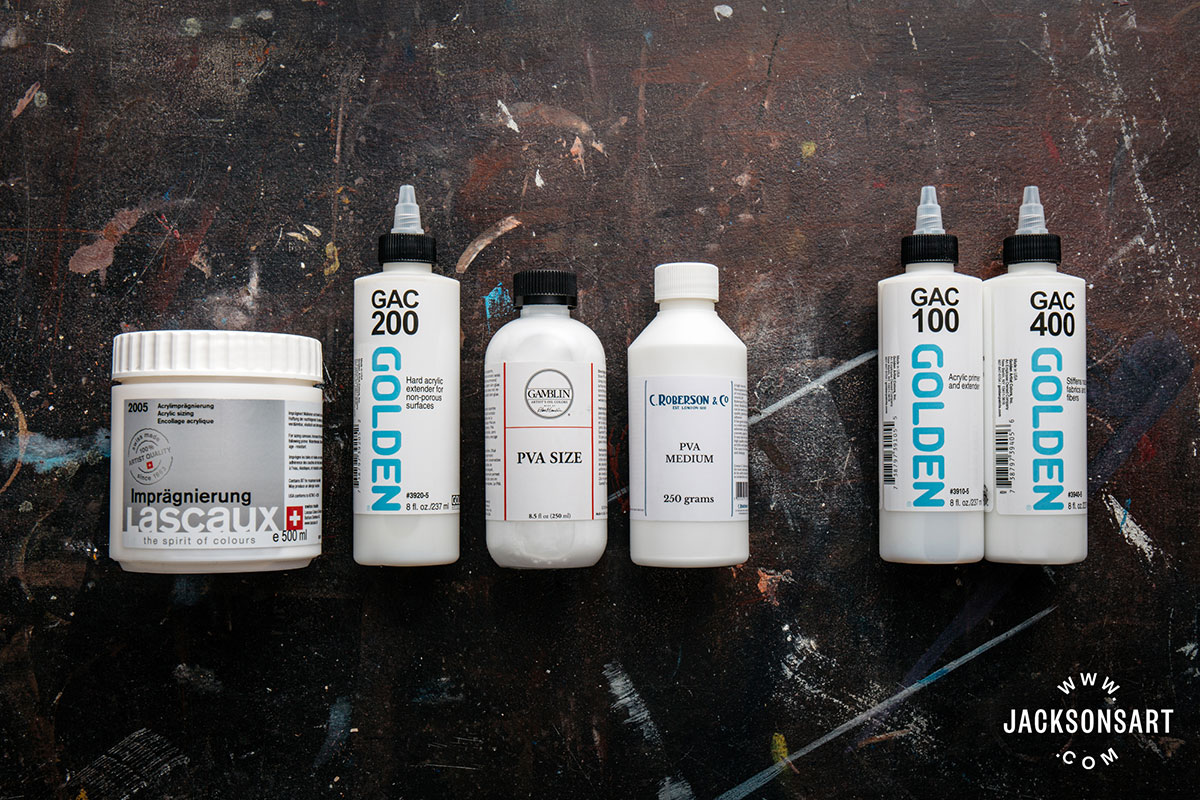
Synthetic Alternatives to Rabbit Skin Gum
In addition to problems of RSG not being perfectly archival some artists are concerned because information technology is an animal production. If this is a concern you may wish to know that although it is made past rendering the gelatine from animals, they are not ordinarily rabbits, the name designates a particular concentration of glue; hide glue is a proper noun given to the same product at a different concentration. RSG is a by-product of the meat market place and no animals are killed just for the glue.
For either of these reasons you may wish to employ a modern constructed alternative to hibernate glue, though they will not work in all situations. Although acrylic sizes are designed for use with acrylic primers and acrylic paints they tin exist used for sizing canvas before applying an oil ground for oil painting. You can utilise one or two coats of GAC 100 or a similar polymer medium straight to the raw sheet, worked well into the weave. If you wish for a stiffer feel utilize GAC 400 for the first coat and GAC 100 for the second coat. Golden Acrylic's latest research seems to point to GAC 200 working like both GAC 400 and GAC 100 so you only need two coats of that on it ain. Since they are acrylic polymer, they are but very slightly hygroscopic, which makes for a much more stable surface over time. Lascaux make a peachy acrylic size. Ara brand a nifty acrylic and casein size. If you want a clear size to allow the colour of a linen sail to show so a polymer gloss medium would be a skilful selection – a matt medium will go out a cloudy surface equally will many clear primers/gessos. And the feel of painting on the plastic surface is very unlike from painting on the RSG surface.
There are also PVA sizes just I take read that a reputable painter and materials researcher does not recommend PVA size equally it is prone to deterioration. But that may be because in that location are over l dissimilar types of formulations of PVA (Polyvinyl Acetate) and merely a few are of a skilful plenty quality to make permanent paintings because they have low acidity, retain flexibility, and have low color modify. Look for pH neutral, sometimes called acrid-complimentary, PVA. PVA non fabricated specifically for artists volition deteriorate and is to be avoided. Gamblin brand an artist-quality PVA size.
Acrylic primer is easier and quicker to use than RSG and true gesso, with more predictable results each time. It is both a size and a basis in i. However, these modern replacements do not stiffen and tighten the canvas every bit well as rabbit peel gum does, in fact they tend to loosen the fabric and so it may demand to be re-stretched after priming, so some artists even so adopt to utilize RSG.
RSG and Related Materials at Jackson's
- Rabbit skin glue
- Whiting
- Oil primer/footing
- Modern synthetic sizes
- Wooden panels
- Unprimed (raw) canvas past the meter
- Clear gum-sized canvas
- Icon soft mottler brushes
- Plastic paint buckets
Related Articles on Our Web log
Our series of posts about artists canvas.
This post was given an update on 21st June 2021.
Source: https://www.jacksonsart.com/blog/2013/04/10/rabbit-skin-glue-2/
Posted by: vinsonarmet1952.blogspot.com


0 Response to "Can I Use Rabbit Skin Glue"
Post a Comment